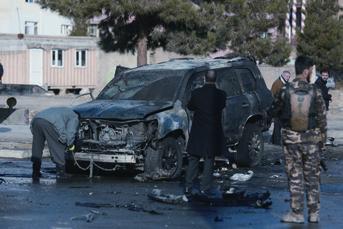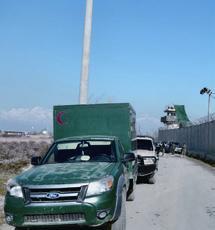Horns of Dilemma
By Li Wei
On the eve of Joe Biden assuming office as the 46th U.S. president on January 20, 2021, the Pentagon is likely to start withdrawing U.S. troops from Afghanistan and Iraq, which is feared to impact the volatile security situation in both countries.
President Donald Trump gave the order in November to reduce the number of U.S. soldiers to 2,500 in each country, following his commitment to get the U.S. out of “endless wars.” The move will affect Afghanistan more, where about 4,500 American troops are deployed, while Iraq has around 3,000. Biden will inherit a dilemma when he takes offi ce.
Controversial decision
On December 2, Chairman of the Joint Chiefs of Staff Mark Milley announced that the Pentagon has approved the plan for partial withdrawal from Afghanistan by January 15 and focusing on “a couple of larger military bases, with several satellite bases” to continue supporting and assisting Afghan security forces in their fight against extremist armed groups, including Al Qaeda and ISIS.But many in the U.S. believe this is not the right time for the withdrawal of U.S. troops.
The Afghan militant group, the Taliban, and Washington signed a deal in Qatars capital Doha on February 29, in which the latter agreed to pull out troops within 14 months if the Taliban followed the terms of the agreement.
The Taliban agreed to sever all ties with Al Qaeda, the militant organization co-founded by Osama bin Laden and responsible for several attacks on U.S. targets. It also agreed not to turn the war-torn country into a haven for terrorists or a battlefield to attack the U.S. in the future. However, violence has surged across Afghanistan despite the deal, and the conditions for U.S. withdrawal havent been met.
The withdrawal is a huge project concerning not only personnel, but also the management and storage of bases, infrastructure and equipment. In fact, the military had been opposed to an early withdrawal, and Defense Secretary Mark Esper was fi red in early November for not agreeing to Trumps plan.
The United States NATO allies have said they find the hasty plan incomprehensible. Currently, 12,000 troops from 38 countries, NATO members and partners, are serving in Afghanistan. NATO has long advocated that they should leave together in a coordinated and orderly way when the time is right.
NATO chief Jens Stoltenberg has said the price for leaving too soon or in an uncoordinated way could be very high, adding that “even with further U.S. reductions, NATO will continue its mission to train, advise and assist Afghan security forces.” NATO is also committed to funding them through 2024.
Despite the criticism and opposition, Trump has remained unmoved and insistent on downsizing U.S. forces. This is a political move to have a card up his sleeve for a future political career.
Before the 2016 presidential election, Trump promised to extricate the U.S. from costly foreign confl icts. While delivering his 2020 State of the Union address, he said, “It is also not our function to serve other nations as a law enforcement agency. These are warfi ghters, the best in the world, and they either want to fi ght to win or not fi ght at all. We are working to fi nally end Americas longest war [in Afghanistan] and bring our troops back home.”
In October, he restated that all U.S. troops in Afghanistan should be “home by Christmas.”
The eagerness to deliver on the campaign promise stems from the desire to build a diplomatic legacy and win votes as he is rumored to run in 2024 in all likelihood and try to make a comeback. This would also limit the Biden administrations policy toward Afghanistan.
Security under threat
With the Afghan Government in need of international assistance to maintain security, the withdrawal may exacerbate the problems and endanger the peace process.According to U.S. Senate Majority Leader Mitch McConnell, the consequences would likely be even worse than the withdrawal from Iraq back in 2011 under President Barack Obamas administration, which resulted in the rise of ISIS and global terrorism.
Extremist and terrorist groups may pop up again. Over the past decade, more than 32,000 Afghan civilians have been killed in terrorist attacks, clashes and air strikes, according to the UN. In September, peace talks between the Afghan Government and the Taliban started in Doha but despite that more than 800 progovernment forces and 300 civilians have been killed in suicide bombings and mine explosions since then.
On December 2, the Afghan Government and the Taliban reached a tentative agreement to move forward on issues such as a ceasefi re. Analysts say Trumps military withdrawal will retard the already slow progress in the talks. Without U.S. support, the Afghan security forces would be weaker, and the Taliban may not agree to a durable end to the civil war.
The Taliban and Al Qaeda have been cooperating on operations and training. Between 400 and 600 Al Qaeda members are active in 12 Afghan provinces and training camps.
A premature U.S. exit would hand Al Qaeda, currently weakened and scattered, a big propaganda victory and a renewed safe haven in Afghanistan.
Besides Al Qaeda, ISIS may also become emboldened and try to take back swaths of the country. There are now reportedly nearly 5,000 ISIS militants in Afghanistan with an international background. They are inciting violence and attacks across the country, bringing terrorism even to the capital, Kabul.
Bidens policy
Biden has been opposed to large-scale counterinsurgency policies, and does not advocate large-scale, unlimited deployment of U.S. troops to combat terrorism. Instead, he favors a light footprint strategy, using special forces and intelligence to work with allies and local partners against Al Qaeda and ISIS.He sees Afghanistan as a dangerous quagmire and had urged that the U.S. should never go deeper into it. However, a certain number of special forces should be kept there and coordinate with allies to mitigate the terrorist threats facing the U.S.
After Bidens election, the Afghan Government has high hopes that the U.S. will put more pressure on the Taliban. The Taliban, on its part, hopes that the new administration will abide by the Doha agreement.
Clearly, Bidens future policy toward Afghanistan faces a major test. Once the withdrawal is complete, it will be seen as a continuation and implementation of Trumps strategy, and Afghanistan may return to becoming a haven for terrorism. But failure to withdraw the troops would violate the Doha agreement, scuttling years of U.S. efforts to negotiate a peace deal with the Taliban.
The Biden administration is likely to renegotiate talks with the Taliban so as to keep a small number of troops or special forces dedicated to fighting terrorism and maintaining stability in Afghanistan, on the ground that a full withdrawal is not immediately feasible.

